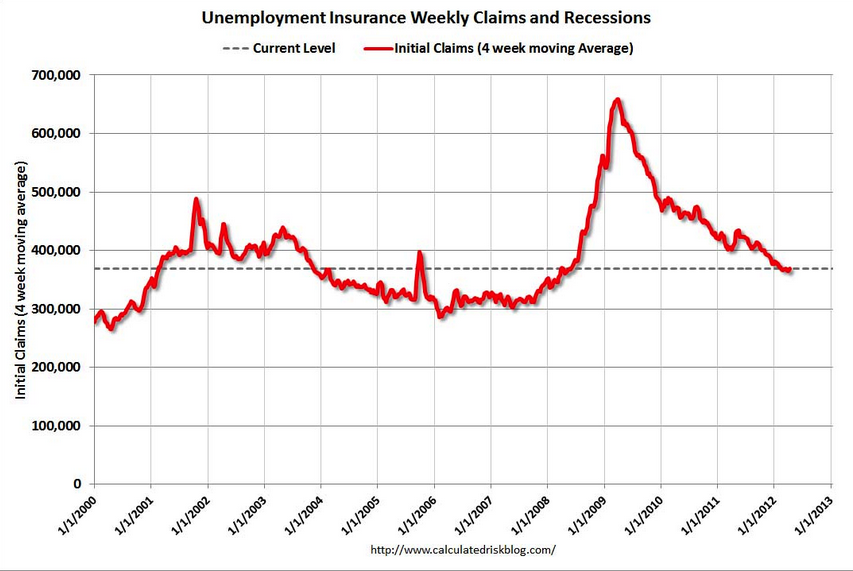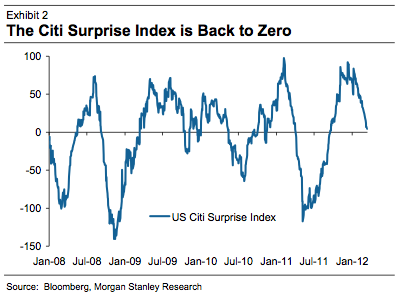
The animal spirits of the US equity market are on display again. There’s been a distinct turn for the worse in US data, clearly illustrating that the US mini-boom of Q4 last year is winding down. That was confirmed again last night with the release of weekly Jobless Claims that climbed 13,000 to 380,000, the highest since January. The series trend is now taking on a distinctly flat look after breaking to new lows in Q411. Here’s the four week moving average from Calculated Risk:

Further domestic weakness was apparent in the February balance of trade with imports down 6.3%. Exports rose slightly which meant the trade deficit fell substantially providing some boost to GDP. Also on better news, the PPI was zero in March indicating that higher oil prices are not yet filtering through to production costs. The annual rate was a mild 2.8%.
As a Morgan Stanley note usefully observed earlier this week, the Citi economic “surprise index” is now at zero:

That is, the economic recovery, such as it is, is priced in.
Of course, the equity market did its usual “opposite world” trick and shot to the moon on suddenly impending Fed stimulus, helped along by yesterday’s dovish Yellen comments.
So is this bad news is good news trade sustainable? I quick thought back to the same period of 2011 should answer that question for you.
Again, Gerard Minack’s team at Morgan Stanley puts it well:
A risk asset correction is underway, and it likely has more room to run. The correction began in credit and in Europe, but the S&P 500 is finally cracking as well, as the sell-off becomes more broad-based and indiscriminate (Exhibit 1). The factors that we thought justified a cautious view and the reasons for taking down risk and adding tail hedges (albeit a bit prematurely in February) still apply: doubts about the US growth acceleration, the return of sovereign risk in Europe sooner than expected, and a central bank “liquidity lull” (Why So Cautious?, March 23). In fact, the entire risk-reward distribution has pivoted in a negative direction, in our view. We expect the sell-off to continue but don’t see US equities correcting more than 10% as the base case. The skew comes from a near-term upside that is likely limited to the recent market highs, while there is a non-negligible chance of a more serious bear case, with corrections greater than 20%.
We wouldn’t make significant changes to the asset allocation at this time. While we see more downside in our base case, it’s not enough to warrant another significant take-down of risk. Our operating assumption is that markets are also likely to trade sideways over the next few months, with a negative risk skew, reminiscent of last year. Skittish investors could trigger a bigger sell-off if macro weakness continues. However, observable metrics and anecdotal evidence suggest that investors in aggregate have higher cash positions and less leverage compared to last year, which should provide a cushion if investors adopt a “buy the dips” approach. Overall, our preference for credit over equities hasn’t changed, and we continue to favor yield and carry strategies, more defensive positioning in equities, positioning against rising sovereign risk in Europe, and tail hedges.
As well as agreeing with my assessment of the US slowing, Morgan Stanley also sees ongoing monetary risk:
The monetary policy safety net is looking less taut All indications are that there will be less monetary easing globally than what looked likely just a couple of months ago. In the US, the March FOMC meeting minutes indicated low sentiment for further accommodation. If the FOMC decides to act, it will be because of deteriorating economic data. Our US economists now see only a one-third probability of the Fed announcing additional stimulus over the next few months, down from 75%, and it’s more likely to be an extension of Operation Twist rather than QE3. The ECB was also less dovish at its latest meeting, keeping interest rates unchanged, with no discussion of future rate changes. Moreover, by highlighting upside risks to inflation, the ECB signaled that rate decreases, let alone more unconventional measures, are probably off the table for a little while. While we don’t believe QE was a main driver in the risk rallies the past few years, if the Bernanke/Draghi “put” now has a lower strike price, risk assets are more vulnerable to a bigger sell-off.
I still see QE3 as live but I agree more pain will be needed to trigger it, just like last year. MS also sees rising European risk:
The LTRO honeymoon for the Eurozone is over The 3y LTRO bought a temporary reprieve, not a solution, to the Eurozone debt crisis. That’s clear because Spain’s CDS spread has risen to a YTD high, while peripheral curves are flattening as front-end yields are rising with the LTRO effect wearing off. Some funding stress indicators have also started to move wider. While this has happened, there’s been little progress on moving towards a fiscal union, elections in France and Greece loom later this month, and peripheral economies continue to weaken. Most worrisome is that the ECB’s ability to save the day again if yields/spreads continue to rise has been diminished. The ECB hasn’t tried recently to stabilize the sovereign markets by purchasing debt through its SMP programme. Moral hazard concerns are one justification; higher yields keep the pressure on politicians to forge ahead with tough austerity and
Most worrisome is that the ECB’s ability to save the day again if yields/spreads continue to rise has been diminished. The ECB hasn’t tried recently to stabilize the sovereign markets by purchasing debt through its SMP programme. Moral hazard concerns are one justification; higher yields keep the pressure on politicians to forge ahead with tough austerity and restructuring measures. But even if the ECB does intervene, the efficacy of its purchases has been impaired by its refusal to take a haircut on its Greek debt holdings. Assuming that set the precedent, any future ECB periphery debt purchases will increase the potential losses for private investors in the event of a debt restructuring. The market will price that in immediately, mitigating somewhat the ECB’s actions. Another 3y LTRO could get around that because banks are buying the sovereign debt. But that benefit could dissipate with each subsequent round, and it could further intertwine sovereign and systemic risk — a feedback loop that needs to be broken.
With the main upside risk in China:
China’s uncertain growth could trigger a positive catalyst China has stopped slowing, but its recovery has been rather muted thus far. This has provided grist for those in the hard-landing camp. In contrast, our China economist Helen Qiao expects this to trigger more effective policy easing and is now forecasting 9% growth for 2012 (A Slow Recovery Opens Up the Door to More Effective Policy Easing, March 28). The key measures she expects include further RRR cuts, a 25bps cut in interest rates, resuming infrastructure investment projects, and promoting first-time home purchases and “commodity housing” construction. However, unlike the last easing cycle in 2009, these measures are smaller and less transparent, which may do little to placate skeptical investors. That has been the case thus far in China, where equities have significantly lagged the rally in the rest of AxJ (Exhibit 4). However, this could set up China and the rest of AxJ for relative outperformance once the stimulus comes, a key factor in our colleague Jonathan Garner’s newly launched coverage of Hong Kong and China (Asia Insight: Initiating Dec ’12 Targets, April 1).
My base case is still a longer and more bumpy correction in China but today’s March credit looks to have stabilised things. and everything else written here makes perfect sense to me.

